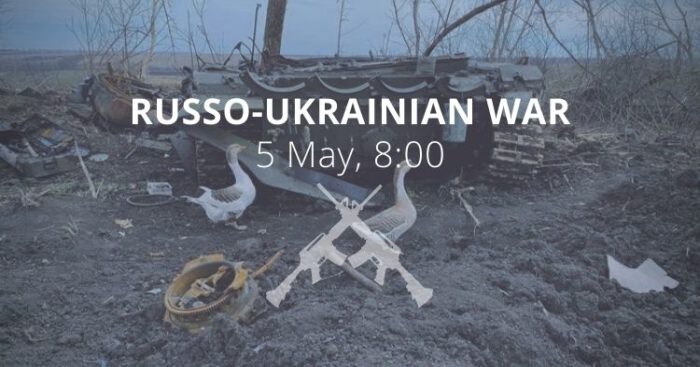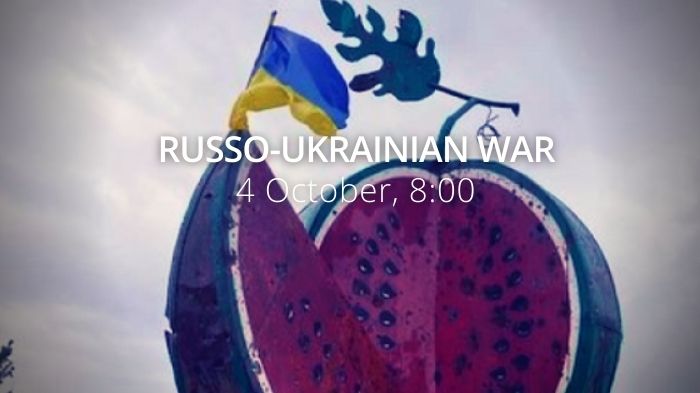EU grants Ukraine candidate status. In Donbas, the Ukrainian army moved away from destroyed Sievierodonetsk to new positions and Russian troops controlled the Lysychansk-Bakhmut “life” route. Ukrainians push back the attack on the southern outskirts of Lysychansk. In the southern direction, Ukrainian soldiers inflicted five airstrikes on the positions of the Russian invaders. PACE finds Russia guilty of downing MH17. The first American HIMARS arrived in Ukraine. Russian State Duma deputy called to launch a missile attack on the US embassy in Kyiv.
Daily overview — Summary report, June 23
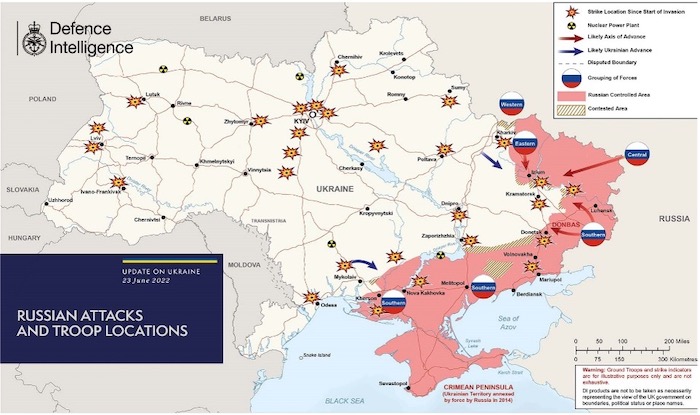
The General Staff’s operational update regarding the Russian invasion as of 06.00 am, June 24, 2022 is in the dropdown menu below.
According to information from the General Staff as of 06.00 24.06.2022, supplemented by its [18:00 assessment].
“Russian forces do not cease offensive operations in the Eastern Operational Zone to establish full control over the territory of Donetsk and Luhansk regions; maintain the land corridor between these territories and the temporarily occupied Ukrainian Crimea; block sea communications of Ukraine in the north-western part of the Black Sea, and maintain the occupied areas of the Kherson and part of the Zaporizhzhia areas and attempts of creation of favorable conditions for the resumption of offensive in the Mykolayiv area.
Russian forces continue to launch missile strikes on critical civilian infrastructure in Ukraine.
In the Volyn and Polissya directions without special changes. On the territory of the Republic of Belarus, there is an increase in the system of engineering and fortification equipment of defense positions in the areas bordering Ukraine and the European Union. [There were no signs of the formation of enemy offensive groups. Units of the Armed Forces of the Republic of Belarus continue to perform tasks to cover the Belarusian-Ukrainian border. Mobilization exercises are held with the military commissariats of some regions, where issues of notification and manning of military units are worked out.]
In the Siversky direction, Russian forces fired on civilian and military infrastructure in the areas of the settlements of Tovstodubove, Bachivsk, Hlukhiv, and Manukhivka in the Sumy Oblast. [Russian forces continue to provide enhanced protection of the Ukrainian-Russian border. It fired on civilian infrastructure in the areas of the settlements of Stari Vyrky, Atynske and Starykove.]
https://twitter.com/EuromaidanPress/status/1539947775105851393
[In the Slobozhansky direction:]
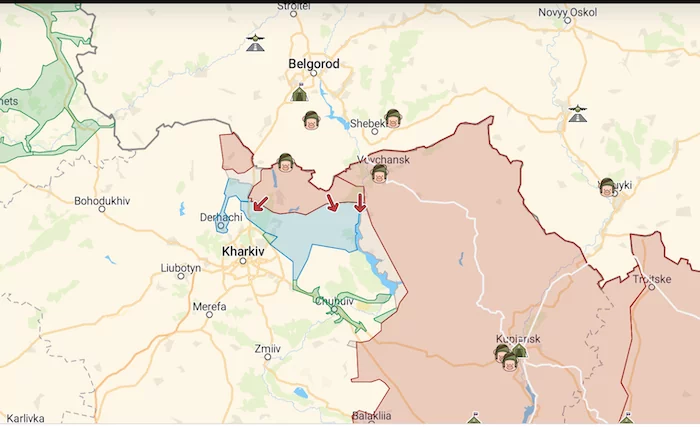
· In the Kharkiv direction, Russian forces inflicted artillery strikes in the districts of Kharkiv, Staryi Saltiv, Korobochkyne, Pechenihy, Dementiyivka, and Zolochiv. Intensified the activities of sabotage and reconnaissance groups. [Yesterday, Russian forces carried out artillery shelling of civilian and military infrastructure in the areas of the settlements of Kharkiv, Ruska Lozova, Pechenihy, Khrestyshche, Mospanove, Stary Saltiv, Ruski Tyshky, and Pryshyb.]
· In the Sloviansk direction, Russian forces fires artillery at civilian infrastructure in the areas of the settlements of Bohorodychne, Krasnopillya, Kurulka, Chervone, Ridne, and Chervona Polyana. [Yesterday, Russian forces fired on civilian infrastructure from artillery and rocket-propelled grenade launchers in the areas of Bohorodychne, Adamivka, Dibrivne, Kurulka, Petrovske, Virnopillya and Mazanivka. Our soldiers repulsed an enemy assault near Dolyna and Bohorodychne and forced the occupiers to withdraw.]
[In the Donetsk direction, Russian forces continue to fire on units of the Defense Forces with artillery and MLRS, mortars and tanks along the line of contact. They focused their main efforts on the Sievierodonetsk and Bakhmut areas to establish control over the settlements of Sievierodonetsk and Mykolayivka. It is fixed on previously captured positions in the districts of Loskutivka and Raiy-Oleksandrivka. It is trying to replace the losses.]
· [Russian forces did not take active action in the Kramatorsk direction.]
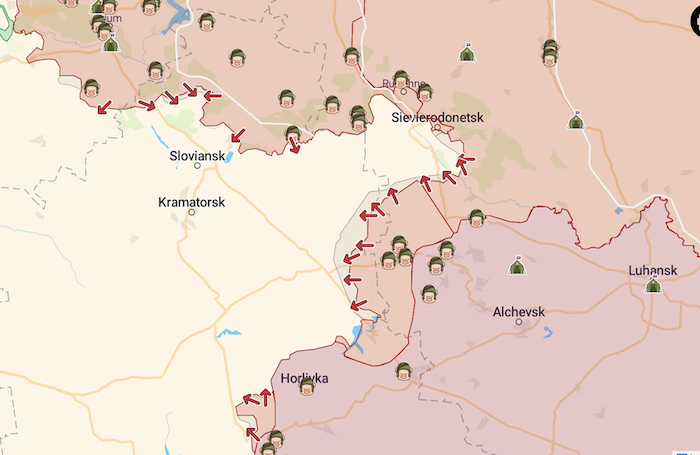
· In the Sievierodonetsk direction, Russian forces fired from tanks, mortars, artillery and MLRS near Lysychansk, Sievierodonetsk, Bila Hora, Vovchoyarivka, Spirne and Berestove. It launched airstrikes on the settlements of Lysychansk and Borivske. Fighting continues for the city of Sievierodonetsk. [Yesterday, Russian forces engaged the settlements of Syrotyne, Lysychansk, Sievierodonetsk, Voronove and Myrna Dolyna with all weapon systems. Units of the 2nd Army Corps, with the support of National Guard units, carried out assault operations to establish full control over Sievierodonetsk. The fighting continues.]
· The occupiers launched an offensive near the settlement of Myrna Dolyna, and hostilities continue. Our soldiers successfully stopped Russian forces’ offensive near Borivske. [Yesterday, our soldiers stopped the offensive in the direction of the southern outskirts of Lysychansk, inflicted losses on Russian forces and forced them to retreat. To resume the offensive, the occupiers put forward reserves. The Ukrainian defenders also stopped Russian forces’ offensive near Borivske.]
· [Russian forces conducted reconnaissance by fighting in the area of the settlement of Bila Hora. The offensive continued near the settlement of Raiy-Oleksandrivka, and fighting continues.]
· In the Bakhmut direction, Russian forces fired at artillery positions of our troops near Mykolayivka, Berestove, and Novoluhansk. It is trying to improve the tactical position and take control of the existing routes. [Yesterday, Russian forces fired artillery of various calibres at our positions in the areas of the settlements of Mykolayivka, Berestove, Klynove, Toretsk, Novoluhansk, Pokrovske, Luhanske, and Kodema. The army aircraft of the invaders struck near Klynove.]
· [The occupiers are trying to establish control over the village of Hirske. The forces of assault groups from the 1st Army Corps captured Mykolayivka. The failure of Russian forces ended the reconnaissance through fighting near the village of Vershyna.]
· [Russian forces tried unsuccessfully to block the actions of our units in the Klynove area.]
· In the Novopavloisk direction, Russian forces fired in the areas of the settlements of Antonivka, Vuhledar and Zolota Nyva. [In Yesterday, Russian forces fired at the positions of our troops from tanks and artillery near Pavlivka, Vuhledar, and Prechystivka. It struck airstrikes in the areas of Pavlivka, Vuhledar and Shevchenko. Near Shevchenko, our soldiers gave the occupiers a fierce battle and forced them to retreat.]
· [To identify weaknesses in our defence, the occupiers used sabotage and reconnaissance groups in the areas of the settlements of Vremivka, Novosilky and Neskuchne. Ukrainian soldiers successfully discovered them — Russian forces withdrew with heavy losses.]
· Russian forces did not conduct active hostilities in the Avdiivka, Kurakhiv and Zaporizhzhia directions. In order to prevent the transfer of reserves to threatening areas, Russian forces fired at our troops in the areas of the settlements of Avdiivka, Umanske, Vesele, Novobahmutivka, Huliaipilske, Bilogirya, and Staroukrainka. [Yesterday, they fired at the positions of our troops from tanks, mortars, artillery and MLRS in the areas of Avdiivka, Pisky, Opytne, Marinka, Hrushove, and Novopola.]
· [Our soldiers strongly suppressed Russian forces’ attempt to attack Marinka.]
· The occupiers are trying to demine the waters of the Berdiansk seaport.
In the Pivdennyy Buh direction, Russian forces did not take active action. They defend themselves and try to conduct counter-battery fire. Inflicted an airstrike on the positions of our troops in the area of the settlement of Bila Krynytsia. [Yesterday. they fired on civilian infrastructure artillery and MLRS in the areas of the settlements of Dobryanka, Mykolayivka and Trudolyubivka. It launched an airstrike on the positions of our troops near Knyazivka. To detect changes in the position of our units and adjust the fire, it conducted aerial reconnaissance of UAVs.]
[In the waters of the Black Sea and the Sea of Azov, the Black Sea Fleet is trying to maintain a favorable operational regime. Five high-precision weapons carriers are being held ready to launch missile strikes on targets in Ukraine.]
Ukrainian aircraft struck Russian forces clusters in relevant areas.
Ukrainian guerrillas continue to resist in the temporarily occupied territories. The total resistance of Ukrainians continues. [Not feeling support among the inhabitants of the temporarily occupied Ukrainian territories, the occupiers are afraid of total resistance from the local population. As a result, they carry out illegal searches, arrests and imprisons.
Military Updates
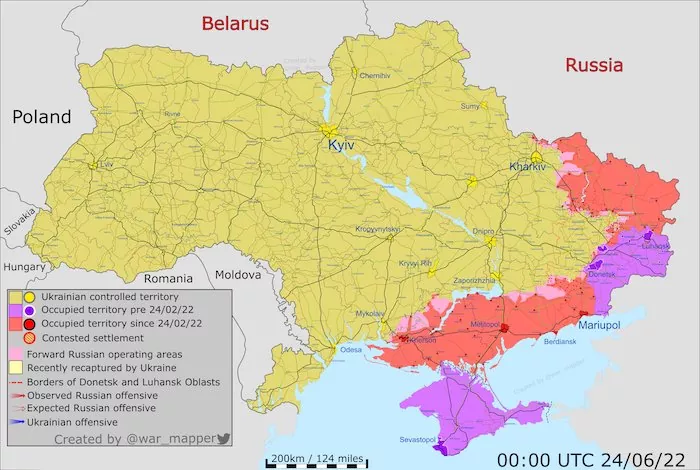
Belarus may provide Russia with weapons and equipment for military action in Ukraine, Ukrainska Pravda reports, citing Oleksii Hromov, the deputy head of the Main Operational Department of the Ukrainian General Staff. “According to existing reports, military equipment is currently being taken out of storage and serviced at military bases on the pretext that it is to be used in military training. Given Russia’s considerable losses of weapons and military equipment, and also the somewhat better state and storage conditions of such equipment in the storage facilities of the Armed Forces of Belarus, it is not beyond the realms of possibility that our neighbor will be providing the Russian aggressor with said weapons and military equipment.
The equipment could then be moved to the Donetsk or Kherson fronts in order to strengthen Russian forces’ groupings. According to Hromov, it has also been discovered that Belarus is actively constructing military infrastructure on the territory of the former Zyabrovka air base in Gomel Oblast, Belarus (near Chernihiv).”
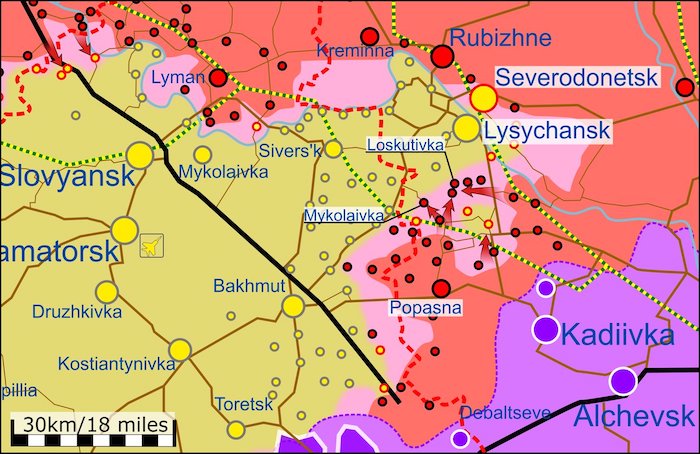
Ukrainian forces in Sievierodonetsk might retreat — Luhansk Military Administration, Ukrainska Pravda reports. “Serhii Haidai, head of the Luhansk Oblast Military Administration, said that Ukrainian defense forces in Sievierodonetsk might retreat to better-fortified positions.”
The operation against the occupiers on Zmiinyi (Snake) Island will continue until his full release, the Head of the Defence Intelligence of Ukraine (DIU), Major General Kyrylo Budanov, claims. “The Russian forces are deploying a group on the island, which consists of air defense units, as well as units armed with MLRS units. In addition, the island has a boat group and special forces. The operation is ongoing. Fire damage is inflicted on these objects. The operation will continue until the complete liberation of Zmiinyi (Snake) Island, he said.”
2,709 missiles have already been launched against Ukraine, Ukrinform reports. “As of this morning, 2,709 missiles have already been launched at Ukraine, and given the pace of their use, the total number will soon reach 3,000[, President Zelensky said]. These are no primitive missiles. Of course, there are outdated, Soviet-era, made even in the 1960s, but there are also modern ones. Nevertheless, Russian missiles, bombs, and artillery are indiscriminate,” the president stressed.”
Drone crashes into a Russian oil refinery Wednesday in a possible attack, The Guardian reports. “Video shared on social media showed the unmanned aerial vehicle crashing into the Novoshakhtinsk oil refinery, in Rostov, in what would be an embarrassing penetration of Russia’s air defense systems in its ongoing war in Ukraine. Ukraine has used drones during the war but did not claim responsibility for the alleged attack.
If the attack at the refinery is confirmed, it would indicate that the drone was either launched from within Russia or that it had passed over Russian-controlled territory to reach the refinery, passing through Russian air defense systems along the way.”
No threat of invasion to Ukraine from Belarus at the moment — intelligence chief, Ukrinform reported Wednesday. At the moment, there is no threat of invasion from Belarus. If the threat arises, the Ukrainian side will take appropriate actions. The relevant statement was made by the Head of the Defence Intelligence of Ukraine, Ministry Kyrylo Budanov. “At this stage, there is no threat on the Belarusian side. I can say this with absolute confidence. The situation is completely under control, Budanov told.
The Ukrainian intelligence is aware of Belarusian reserve duty training exercises, border enhancement procedures, and a whole range of military-oriented actions. But, they are not aimed at conducting hostilities against Ukraine at this stage. When such thoughts arise, we will immediately know about them and will take appropriate actions, Budanov stressed. A reminder that Belarus started 10-day mobilization exercises, involving military commissariats in Gomel Region, bordering with Ukraine.”
According to British Defence Intelligence, (last 48 hours):
· Ukrainian forces have announced that the pilot of a Russian Su-25 FROGFOOT ground attack aircraft shot down on 17 June was captured shortly afterwards. The pilot has confessed to being a former Russian air force Major, who had taken employment as a Wagner military contractor and had flown several missions during the conflict.
· The use of retired personnel, now working as Wagner contractors, to conduct close air support missions indicates that the Russian air force likely is struggling to support the invasion of Ukraine with sufficient aircrew. This is likely due to a combination of Russia’s insufficient numbers of suitably trained personnel and its combat losses.
· Whilst conducting his missions, the Russian pilot reportedly used commercial GPS devices rather than Russian military navigation equipment. This likely indicates that Wagner aircraft are older models of the Su-25 and that the Russian air force is not providing Wagner with up-to-date avionics equipment.
· Since 19 June, Russian forces have highly likely advanced over 5km towards the southern approaches of the Donbas city of Lysychansk. Some Ukrainian units have withdrawn, probably to avoid being encircled. Russia’s improved performance in this sector is likely a result of recent unit reinforcement and heavy concentration of fire.
· Russian forces are putting the Lysychansk-Sievierodonetsk pocket under increasing pressure with this creeping advance around the fringes of the built-up area. However, its efforts to achieve a deeper encirclement to take western Donetsk Oblast remain stalled.
Losses of the Russian army
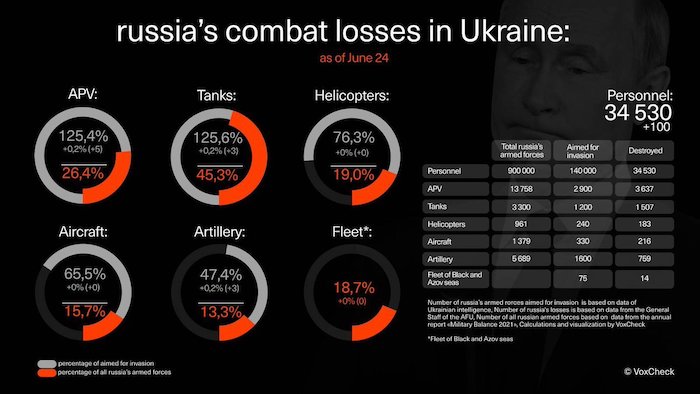
As of Monday 24 June, the approximate losses of weapons and military equipment of the Russian Armed Forces from the beginning of the war to the present day:
- Personnel — more than 34530 (+100),
- Tanks — 1507 (+3),
- Armored combat vehicles — 3637 (+5),
- Artillery systems — 759 (+3),
- Multiple rocket launchers –MLRS — 241 (+1),
- Air defense means — 99 (+0),
- Aircraft — 216 (+0),
- Helicopters — 183 (+0),
- Automotive technology and fuel tanks — 2553 (+5),
- Vessels/boats — 14 (+0),
- UAV operational and tactical level — 622 (+2),
- Special equipment — 60 (+0),
- Mobile SRBM system — 4 (+0),
- Cruise missiles — 137 (+0)
Russian enemy suffered the greatest losses (of the last day) in the Sloviansk and Bahmut directions.
⚰️russia's combat losses in Ukraine as of June 24
▪ 34530 killed soldiers (+100)
▪ 1507 tanks (+3)
▪ 3637 APV (+5)
▪ 759 artillery systems (+3)
▪ 216 aircraft and 183 helicopters
▪ 14 boats and cutters#StopRussia #StandwithUkraine pic.twitter.com/2JiVqmpiaB— VoxUkraine (@voxukraine) June 24, 2022
Humanitarian
Ukraine and Europe will prevail! A message from Ukraine's Foreign Minister https://t.co/fImTeKdc2e
— Euromaidan Press (@EuromaidanPress) June 23, 2022
In the report “Enabling the local response: Emerging humanitarian priorities in Ukraine”, the UK Humanitarian Innovation Hub has analysed the evolving aid response to the Russian invasion of Ukraine.
“A bottom-up, demand-driven humanitarian response with a limited international presence. For the first six weeks post-invasion, virtually all humanitarian aid inside Ukraine was organized and implemented by local actors, including around 150 pre-existing national NGOs, church groups, and around 1,700 newly formed local aid groups. An informal aid sector has developed organically, with groups largely following a similar operational model: volunteers pooling personal resources, responding to incoming requests for assistance in their area, and incrementally expanding their reach as resources allow. These groups (together with local authorities), remain the principal aid providers but are quickly being exhausted of funds, fuel, and physical energy. The groups that are actively scaling up and becoming registered as new aid organizations have done so by finding donors mostly from outside the formal humanitarian sector. Among the international aid organizations already engaged in Ukraine, an acknowledged lack of preparedness and contingency planning for a full-scale Russian invasion meant time was lost in re-entry and scale-up. Active combat in parts of the country presents a serious obstacle for many organizations, including those who had been operating in Ukraine prior to the invasion, most of which had shifted to non-emergency, resilience-oriented programming. At the time of writing, around two dozen international NGOs, together with the UN humanitarian agencies and the International Committee of the Red Cross (ICRC), had staff and programmes starting up inside Ukraine. Operational data and publicity materials tend to overstate international aid presence inside Ukraine, which is still mostly concentrated in the west of the country and across the border.
Financing bottlenecks and failures of localization. Despite raising significant sums of money in the first days and weeks of the crisis, international organizations could not provide rapid infusions of resources to strengthen and expand the existing local response efforts while they ramped up their own programming. Instead, three months later, most of the money was still unused, sitting with international organizations that are constrained from funding by compliance requirements that are too heavy and time-consuming for small volunteer groups to meet. Even aspirational objectives and benchmarks for ‘localization’ have been absent from international response plans, as have the previously agreed-upon basic tools for national organizations, such as single unified forms to enable simpler funding applications and reporting across multiple international partners.”
Millions of refugees from Ukraine have crossed borders into neighboring countries, and many more have been forced to move inside the country. The escalation of conflict in Ukraine has caused civilian casualties and destruction of civilian infrastructure, forcing people to flee their homes seeking safety, protection, and assistance the UNHCR reports. As of 21 June:
Individual refugees from Ukraine recorded across Europe: 5,256,378
· Belarus, Hungary, Republic of Moldova, Poland, Romania, Russian Federation, Slovakia 2,767,245
· Other European countries 2,489,113
Refugees from Ukraine registered for Temporary Protection or similar national protection schemes in Europe: 3,510,070
· Hungary, Poland, Romania, Slovakia 1,324,703
· Other European countries 2,185,367
Border crossings from Ukraine (since 24 February 2022): 8,007,014
Border crossings to Ukraine (since 28 February 2022): 2,836,563
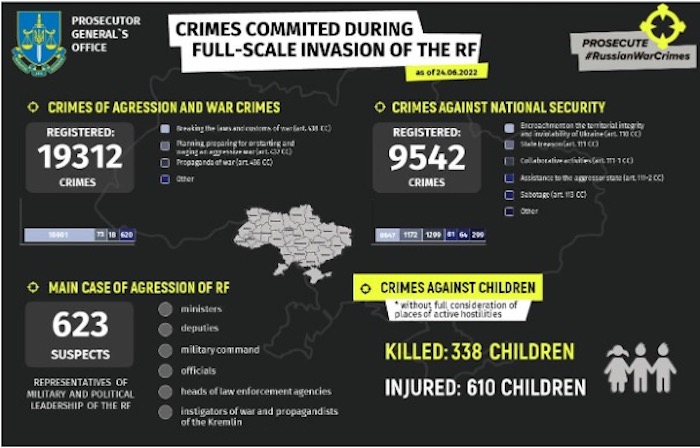
OHCHR recorded 10,465 civilian casualties in Ukraine as of June 22. 4,662 were killed (including 320 children) and 5,803 injured (including 479 children).
Environmental
Ukraine Does Not Confirm Agreements on Grain Exports — MFA, European Pravda reports. “There are no ongoing arrangements for negotiations between Ukraine, Russia, Türkiye, and the United Nations on the export of Ukrainian grain through the ports halted by Russia. Ukraine welcomes the efforts of the UN Secretary-General to resolve the issue of exporting grain from the Russian seaports halted by Russia. Expert consultations between stakeholders are underway, the Ministry of Foreign Affairs spokesman of Ukraine, Oleh Nikolenko, said. We have not yet reached any specific agreements on holding quadripartite negotiations with Ukraine, Russia, Türkiye, and the UN. As before, security remains a fundamental element of Ukraine’s position, he added.
As previously reported, a delegation of the Turkish Ministry of Defense on Wednesday held talks in Moscow to unblock the export of Ukrainian grain by sea. According to the Turkish Ministry of Defense, the meeting took place in a “constructive and very positive atmosphere.” Its participants said they had agreed to hold quadripartite talks with Ukraine and the UN. […]
Earlier, Deputy Foreign Minister of Ukraine Dmytro Senik said that Ukraine had established two channels for grain exports during the Russian naval blockade: Poland and Romania. Ukraine is still negotiating with the Baltic states. […] Addressing the African Union, Volodymyr Zelensky said that Ukraine had not yet made progress in multilateral negotiations to unblock maritime grain exports.”
Russia may cut off the gas completely, Europe must act now — IEA, Reuters reports. “Russia may cut off gas to Europe entirely as it seeks to bolster its political leverage amid the Ukraine crisis, the head of the International Energy Agency (IEA) said on Wednesday, adding Europe needed to prepare now. “This is the reason Europe needs contingency plans”, Birol added, saying a recent reduction in flows may be an attempt to gain political leverage ahead of higher-demand winter months. The IEA did not see a full cut-off as the most likely scenario, he added.”
The EU will temporarily switch to coal to compensate for decreased Russian gas, Ukraine Business News reports. “Elina Bardram, the European Commission’s executive director for international affairs and climate finance, said the EU will temporarily return to using coal-fired power plants to make up for the shortage of Russian gas, reported Reuters. “Russia’s illegal invasion of Ukraine has led to an emergency situation in the EU. We are witnessing the Putin administration’s extremely aggressive steps to reduce Gazprom’s gas supplies and we will undertake critical countermeasures in response, but these measures are temporary,” Bardram said. However, the European Commission’s representative stressed that using coal in the EU does not mean abandoning long-term commitments to climate change.”
Legal
Ukraine Submitted New Application to the European Court of Human Rights against Russia, European Pravda reports. On Thursday, Ukrainian Minister of Justice, Denys Malyuska, said that the Ministry had submitted a new lawsuit against Russia to the court. “The filing made by Ukraine addresses Russia’s egregious human rights violations during the initial phase of the war, from the onset of Russia’s invasion in the early hours of 24 February 2022 until the effective withdrawal of its ground forces from around Kyiv and other cities in northern Ukraine on 7 April 2022 (Russia’s violations in the period thereafter will be addressed by Ukraine in subsequent filings).
By these proceedings, Ukraine seeks, in addition to orders of the Court requiring the status quo to be restored and full withdrawal of Russian forces, an award of monetary compensation for these violations. It is indicated that at the first stage of the Russian military invasion (late February 2022 — April 2022), the damage amounted to at least US $80 billion.
Ukraine’s application seeks an end to the mass and gross human rights violations that are the result of the military aggression launched by Russia. In due course, the Court will be invited to find that Russia has been guilty of the most flagrant, serious, and sustained violations of the Convention ever placed before the Court, and to award just satisfaction on an equally unprecedented scale. Russia’s conduct has embraced both targeted and indiscriminate and disproportionate attacks against civilians and their property across Ukraine in breach of all applicable norms of international law.”
Russia plans to hold “referendums” in Kherson and Zaporizhzhia oblasts on 11 September — Ukrainian intelligence, Ukrainska Pravda reports, citing the Centre for National Resistance. “According to the information obtained by the Ukrainian Resistance movement, Russian occupiers want to hold the so-called “referendums” on the Russian “unified voting day” on 11 September. Russia already plans to hold elections of people’s deputies and governors in several of its regions on this date. However, Russian plans are being met by Ukrainian resistance. No staff want to undertake administrative duties in Russian occupation administrations. At present, the administrations of the Russian-occupied districts in Zaporizhzhia Oblast are staffed by officials from the Russian Federation on a monthly rotation basis.”
338 children were killed, and 610 children injured, the Office of the Prosecutor General of Ukraine reports as of June 24. 2,061 educational establishments are damaged as a result of shelling and bombings, 213 of them are destroyed fully. 19,312 crimes of aggression and war crimes and 9,542 crimes against national security were registered.
Russia handing out passports, putting pressure on locals to speed up the integration of temporarily occupied areas, Ukrinform reports. “Russia is attempting to boost the integration of the temporarily occupied territories by issuing Russian passports and exerting pressure on the local population, including teachers. Ukrainian Deputy Defense Minister Hanna Maliar said.
“In violation of international law, Russia continues to open issue points to hand out Russian passports in the temporarily occupied territories, putting pressure on people who found themselves in the temporarily occupied territories. People working at captured enterprises experience the greatest amount of pressure. Russia coerces Ukrainians who were forced to stay in the temporarily occupied territories into cooperating with them. In particular, it concerns educational staff,” said Maliar. She added that most Ukrainian citizens oppose these actions, but the occupiers in the temporarily occupied territories are suppressing these protests.”
Support
American HIMARS systems have arrived in Ukraine, MIL.IN.UA reports. Oleksii Reznikov, Minister of Defense of Ukraine announced this on Twitter. “On June 1, the United States approved a new package of military assistance to Ukraine, which included HIMARS rocket artillery systems and ammunition for them. Ukraine will be receiving these weapons as part of the $700 million aid package.
https://twitter.com/oleksiireznikov/status/1539931757621006336
The Pentagon later stated that providing Ukraine with several systems is only a starting point. It was further reported that the United States might double the number of HIMARS systems shipped over to Ukraine. This would mean the supply of 4 more weapons systems.”
The US Sending Advanced Rocket Systems, Other Aid to Ukraine, US News reports. “The United States says it is sending another $450 million in military aid to Ukraine, including some additional medium-range rocket systems, to help push back Russian progress in the war. The latest package includes four High Mobility Artillery Rocket Systems, or HIMARS, which will double the number they have now. According to the Pentagon, the aid also includes 18 tactical vehicles that are used to tow howitzers, as well as 18 coastal and riverine patrol boats, thousands of machine guns, grenade launchers and rounds of ammunition, and some other equipment and spare parts.”
Slovakia will hand over 12 MiG-29 fighters to Ukraine — media, Fakty.com reports, citing Business Insider. According to the latter, Bratislava has agreed on a ring exchange with the transfer of Soviet MiG-29 fighters to Ukraine. “According to Visegrad 24, Slovakia plans to hand over 12 MiG-29 fighters to the Ukrainian Air Force. According to Business Insider, the planes will be handed over after Poland and the Czech Republic agree to protect Slovakia’s airspace until the country receives its F-16s from the United States.”
According to Forbes, the German government on Tuesday confirmed it has donated to the Ukrainian government stock of MiG-29 parts, apparently left over from the period following the Cold War when the German air force operated ex-East German MiGs.
US-made jets, air defence on Ukrainian fighter pilots’ wishlist, but not Gray Eagle, Breaking Defense reports. Currently, the Ukrainian Air Force’s priority is securing an American commitment to supply ground-based air defence systems needed to ensure Ukraine can continue to maintain control of its airspace and defend against Russian attacks on civilian infrastructure.
“The ground-based air defence was the key in this war, and it’s still the key [moving forward],” said a Ukrainian MiG-29 fighter squadron commander who goes by the callsign “Moonfish.” However, “we have a lot more pilots than jets at this point,” he said, adding that eventually, the Ukrainian air force is going to need Western fighter jets to replenish the losses sustained by the service. The United States and its NATO allies have been hesitant to provide the jets due to concerns that Ukraine would not be able to absorb Western fighters within a timeframe that would allow the Ukrainian air force to operate them while the war with Russia is still ongoing.
[The Ukrainians] acknowledged that it will take time for the Ukrainian air force to learn how to operate US-made aircraft and mission systems, establish a working knowledge of how to tactically employ the fighters in combat, and sustain the jets. However, both expressed confidence that Ukraine’s more experienced pilots could learn how to operate an F-16 in less than a year. “We are ready to do [the training] more intensively,” Juice said, adding that one way to speed up training would be to have different groups of pilots specialize in different mission sets.
“We need suppression of enemy air defence capability. We need air-to-ground capability and the [biggest] priority is air-to-air capability,” Juice said. “So we could set different groups for each capability and it would be shorter, like a small course for each group. And I believe that we could do it pretty fast.”
New developments
https://twitter.com/EuromaidanPress/status/1540042847868657664
A. EU grants Ukraine candidate status, beginning a long journey together, Reuters reports. “European Union leaders on Thursday granted Ukraine the coveted status of an official candidate to join their 27-nation club, a bold geopolitical step hailed by Kyiv and the EU itself as a historic moment. The Ukrainian people belong to the European family. Ukraine’s future is with the EU, the bloc’s foreign policy chief Josep Borrell said. Today marks the beginning of a long journey that we will walk together.”
https://twitter.com/EuromaidanPress/status/1540107478423191552
B. A peace treaty with Ukraine is possible if Kremlin ultimatums are met, Ukrainska Pravda reports, citing Interfax. “Kremlin spokesman Dmitry Peskov said that the signing of a peace treaty with Ukraine is possible if Russia’s demands are fully met.”
C. Germany triggers gas alarm stage, accuses Russia of ‘economic attack’, Reuters reports. “Germany triggered the “alarm stage” of its emergency gas plan on Thursday in response to falling Russian supplies but stopped short of allowing utilities to pass on soaring energy costs to customers in Europe’s largest economy. The measure is the latest escalation in a standoff between Europe and Moscow since the Russian invasion of Ukraine that has exposed the bloc’s dependence on Russian gas supplies and sparked a frantic search for alternative energy sources. The step is a largely symbolic signal to companies and households but marks a major shift for Germany, which cultivated strong energy ties with Moscow stretching back to the Cold War.”
D. Boris Johnson signals UK’s willingness to demine, and help export grain from Ukraine, Reuters reports. “Prime Minister Boris Johnson said on Thursday Britain was willing to assist with demining operations off Ukraine’s southern coast and was considering offering insurance to ships to move millions of tonnes of grain stuck in the country. London’s insurance market has placed the entire region on its high-risk list meaning soaring costs for shipments.”
E. State Duma deputy warns US Embassy in Kyiv will “sooner or later” be a military target, Ukrainianska Pravda reports, citing Lenta.ru. “This (supply of HIMARS — UP) once again highlights the step-by-step movement towards World War III by the United States. It should be understood that we must react harshly. In my opinion, the reaction today should also apply to those countries that supply weapons (to Ukraine — UP)[, Yury Shvytkin, Russian State Duma deputy and Deputy Chairman of the Committee on National Defence, said]. And this isn’t just about destroying infrastructure or anything, but I think the main decision-making centre is the US embassy. I think that sooner or later it will become a target for the Russian Armed Forces, the national police of the “DNR” and “LNR”. My position is that the government quarter in Kyiv should be destroyed.”
https://twitter.com/EuromaidanPress/status/1540077235729707009
Assessment
- On the war.
The Institute for the Study of War has made the following assessment as of Sunday 24 June, 2022:
- On the War
The Institute for the Study of War has made the following assessment as of Thursday 23 June:
“Ongoing Belarusian mobilization exercises will continue in Gomel Oblast until July 1 but are unlikely to be in preparation for direct Belarusian involvement in the war in Ukraine. The Belarusian Ministry of Defense announced on June 22 that the Belarusian Armed Forces will conduct a mobilization exercise with the military commissariats of Gomel Oblast to test the readiness of the military reserve from June 22 to July 1. The Ukrainian State Border Guard Service warned on June 23 that Belarusian forces may conduct provocations along the border with Ukraine over the backdrop of these exercises, and Belarusian-Russian military cooperation has seemingly intensified. Belarusian Defense Minister Viktor Khrenin met with Russian Defense Minister Sergey Shoigu in Moscow on June 23 to discuss ongoing bilateral military agreements. Belarusian social media users additionally reported that Russian planes transported at least 16 S-400 missiles and one Pantsir system to the Gomel airport on June 21 and 22.
While Belarus and Russia retain close military cooperation and the ongoing Belarusian exercises are likely intended in part to threaten Ukraine, Belarus remains unlikely to enter the war in Ukraine on behalf of Russia. As ISW has previously assessed, Belarusian President Aliaksandr Lukashenka likely cannot afford the domestic consequences of involving his limited military assets in a costly foreign war. Unsupported Belarusian forces are additionally highly unlikely to be effective, and Russia lacks the reserves necessary to conduct another offensive toward Kyiv. These exercises are undoubtedly intended to posture and threaten Ukrainian border areas but are unlikely to preempt actual involvement in hostilities.
Russian forces have made substantial gains in the Sievierodonetsk-Lysychansk area over the last several days and Ukrainian troops continue to suffer high casualties, but Ukrainian forces have fundamentally accomplished their objective in the battle by slowing down and degrading Russian forces. Head of the Luhansk Oblast Administration Serhiy Haidai stated on June 23 that Ukrainian troops may have to retreat to avoid encirclement in Lysychansk, which indicates that Ukrainian authorities are setting conditions to prepare for the ultimate loss of both Sievierodonetsk and Lysychansk. As ISW has previously assessed, however, the loss of Sievierodonetsk and Lysychansk will not represent a major turning point in the war. Ukrainian troops have succeeded for weeks in drawing substantial quantities of Russian personnel, weapons, and equipment into the area and have likely degraded Russian forces’ overall capabilities while preventing Russian forces from focusing on more advantageous axes of advance. Russian offensive operations will likely stall in the coming weeks, whether or not Russian forces capture the Sievierodonetsk-Lysychansk area, likely granting Ukrainian forces the opportunity to launch prudent counteroffensives. The Kremlin’s ideological fixation on the capture of Sievierodonetsk, much like the earlier siege of Azovstal, will likely be to the ultimate detriment of Russian capabilities in future advances in Ukraine. The loss of Sievierodonetsk is a loss for Ukraine in the sense that any terrain captured by Russian forces is a loss — but the battle of Sievierodonetsk will not be a decisive Russian victory.
Key Takeaways
- Belarusian forces are conducting mobilization exercises along the Ukrainian border but are unlikely to enter the war in Ukraine due to their low capabilities and the adverse domestic implications of military involvement on behalf of Russia.
- Russian forces have likely reached the southern outskirts of Lysychansk and are reinforcing their grouping around Sievierodonetsk to complete the capture of both Sievierodonetsk and Lysychansk. These gains remain unlikely to provide Russian forces with a decisive edge in further operations in Ukraine and have further degraded Russian capabilities.
- Russian forces are continuing efforts to encircle the Ukrainian grouping in Hirske and Zolote and are likely moving to take control of these settlements.
- Russian forces have likely successfully interdicted Ukrainian lines of communication along the T1302 highway and are using recent gains along the highway to reinforce assaults on Lysychansk.
- Russian forces amassed equipment and continued building defensive capabilities along the Southern Axis.“
The arrival of Western weapons begins to reshape the battle off Ukraine’s coast, The New York Times argues. “As Ukrainian forces launch a renewed assault on Zmiinyi (Snake) Island in the Black Sea, recent strikes suggest that they are using powerful Western anti-ship weapons to undermine Russian naval domination.
The Ukrainian military’s southern command said late on Tuesday that it was using “various forces and methods of destruction” to attack Russian infrastructure on Zmiinyi (Snake) Island, a speck of land south of Odesa that is critical to efforts to control the Black Sea. On Wednesday morning, the military said it had destroyed a Russian air defence system, radar installation and vehicles on the island. The current round of fighting around Zmiinyi (Snake) Island appeared to kick off on Friday when the Ukrainians struck a Russian naval tugboat as it was on a mission to deliver weapons and personnel to the island.”
2. Consequences and what to do?
How the cloud saved Ukraine’s data from Russian attacks, Defense News reports. “As the multi-pronged invasion commenced [on 24 February], cruise missiles struck a Ukrainian governmental facility housing servers full of important data. At the same time, Russian cyber operatives conducted “wiper attacks” on computer networks — attempting to delete all the stored information.
Despite the sophisticated and holistic nature of the Russian attack, the Ukrainian data survived the onslaught. For a week earlier, it had been virtually smuggled out of the country. The data which had once singularly been stored on physical servers had been uploaded to the cloud.
“The key to a country’s digital resilience in wartime is the ability quickly to move data outside the country while still connecting to and relying on it for a government’s digital operations,” according to a report from Microsoft on the cyber lessons of the Ukrainian war. “One reason these kinetic and cyberattacks have had limited operational impact is because digital operations and data have been disbursed into the public cloud,” it said.”
Rallying around the European flag | Democracy as an anchor point in times of crisis, European Parliament Eurobarometer Spring 2022 Survey reports. The Russian war of aggression against Ukraine is very much on citizens’ minds: close to three-quarters of Europeans follow news related to the latter closely (72% overall). China and Russia return the lowest positive rates with 22% and 10% respectively. In 2018, China and Russia still projected positive images with 36% and 30% of respondents respectively.
· In the face of the Ukraine war, 61% of Europeans are not confident that their life will continue unchanged. Only around a third (37%) believe it will.
· 40% of Europeans already experience a reduction of their standard of living. A further 47% expect such an impact to happen over the next year. Only one in ten (11%) think the war will not affect their standard of living.
· 58% of respondents say they are not ready to face increasing energy prices, while 59% are not ready for higher food prices.
· Nearly six out of ten respondents (59%) say the defence of common European values such as freedom and democracy is more important than maintaining prices and the cost of living. This is also the relative majority view in 20 Member States.
· Defending the value of democracy has become even more important for European citizens: 38%, a plus of 6 points, put democracy front and centre, followed by ‘freedom of speech and thought’ and ‘the protection of human rights in the EU and worldwide’ (both 27%).
“This isn’t just Ukraine’s war. It’s our war, too. Act accordingly”, Max Boot argued in The Washington Post. “US military [and European] assistance to Ukraine has been good but not good enough. In part, that’s because of a conceptual error we keep making. We keep thinking it’s their war. We should understand that this is our war and act accordingly.
Russia didn’t just attack one country. It attacked the very foundation of the rules-based international order the United States and its allies have been building since 1945. If Russia gets away with its aggression, that will send a signal to dictators around the world that they can do what they want and that the West is too weak to stop them. Look for Russian dictator Vladimir Putin to set his sights on the NATO-member Baltic Republics, which, like Ukraine, were part of the Russian Empire at various times in history. Look for China to set its sights on Taiwan. An attack on either the Baltics or Taiwan would be likely to draw the United States into a conflict that could easily spiral into World War III.
The best way to keep the peace is to help Ukraine throw back the Russian invaders with devastating losses. That would send a powerful message not only to Putin but also to every tinhorn dictator on the planet: Don’t mess with the West. But that’s not what we are doing. We are providing the Ukrainians with just enough weaponry to avoid defeat — but not enough to win. The Ukrainians are outgunned 10 to 1 in artillery in the critical battle being fought in the eastern Donbas region. That’s unacceptable.
We would not be so stingy if US troops were on the front lines. According to Brown University’s Costs of War Project, since Sept. 11, 2001, the United States has spent more than $3 trillion on the war on terror, which encompassed the conflicts in Iraq and Afghanistan. (That doesn’t count trillions more for veterans’ care and homeland defense.) That’s an average of $12 billion every month for almost 21 years.
By comparison, since the Russian invasion of Ukraine on Feb. 24, the United States has committed only $5.6 billion in security assistance, with the latest tranche of $1 billion announced last week. That’s an awful lot of money if measured by foreign aid, but it’s a pittance compared to what we spend on our own wars. If this had been a US conflict, we might have spent $48 billion or more since February.
That’s nearly an order of magnitude difference, which helps explain why our aid packages fall so short of what the Ukrainians are requesting. A top aide to President Volodymyr Zelensky says that to achieve “heavy weapons parity” with the invaders, Ukraine needs 1,000 155mm howitzers, 300 multiple-launch rocket systems, 500 tanks, 2,000 armored vehicles and 1,000 drones. The United States has so far pledged 126 155mm howitzers, four High Mobility Artillery Rocket Systems, 200 armored personnel vehicles and 121 Phoenix Ghost drones. Our allies have made some critical contributions of their own but, taken together, it’s not enough.
The United States has entirely failed to provide any tanks or aircraft. Not only has the Biden administration not sent F-16 fighter jets or A-10 ground-attack aircraft, it also refused to facilitate a transfer of MiG-29 fighter jets from Poland. Retired Air Force Lt. Gen. David Deptula says that the United States has more than 200 MQ-1C Gray Eagle drones in storage that could be shipped to Ukraine. Armed with Hellfire missiles, these drones could help turn the tide in Donbas. But the Biden administration so far hasn’t sent a single Gray Eagle. […]
The Biden administration and its defenders have many excuses for not doing more. We don’t want to be drawn into a war with Russia. The situation isn’t as critical as the Ukrainians claim. They can’t absorb too much equipment too quickly. The Russians will simply destroy or capture our systems. The United States has limited stockpiles. It takes time to move heavy weapons and set up supply lines for them. While we can’t match the Russians in quantity, our equipment is of higher quality — so we don’t need to deliver it in the numbers the Ukrainians want. And so on.
Most of these explanations are valid, but none is really adequate to explain our failure to do more. Policymakers should keep asking themselves, “What would we do if GIs were dying in Donbas?” and act accordingly. That doesn’t mean that we should directly attack Russia. It does mean that we should be providing Ukraine with the resources to win the war that Russia is waging against the entire West.”
Hans Petter Midttun: Today marks four months to the day after Russia made the historical and strategic blunder of invading Ukraine.
It is occupying less territory than it did three months ago. A combination of fierce Ukrainian resistance, military blunders, technical problems, lack of logistics, the worst ever intelligence, and consequential huge losses of both manpower and equipment, forced Russia to withdraw from the northern axis (Volyn, Polissya, Siversky and Slobozhansky directions).
Nations do not wage war for war’s sake but in pursuance of policy in which a better state of peace is the main objective.
Russia has in contrast succeeded in making a peaceful neighbor a mortal enemy until the end of time. Its atrocities and attempt to stump out the Ukrainian nation will never be forgotten or forgiven.
It has also united both NATO and the EU to a level not observed since the Cold War. The very foundation of the Russian Federation is being threatened by both the unprecedented sanctions as well as the shifts in policy aiming to reduce the European economic ties to Russia. Western industry and business are departing Russia en mass. Maritime shipping is avoiding its ports. Russia is being denied access to Western airspace and ports.
It has failed to mobilize the CSTO behind its aggressive foreign policy, probably for that exact reason: Its aggressive foreign policy and imperial ambitions threaten all of its neighbors. Belarus has until now avoided deploying its Armed Forces in direct support of the Russian warfighting in Ukraine (while not only allowing Russia to use its territory to attack Ukraine but also deploying Belarusian forces to the border to deny Ukraine the opportunity to deploy forces east- or southwards). Kazhakstan will not even recognize the self-proclaimed independence of Ukraine’s Donetsk and Luhansk regions.
HOWEVER …and a big BUT …
Despite this, Russia is escalating the conflict. Having been militarily “undressed” by Ukraine, Russia continues to act as a great power due to its position as a nuclear power.
Its belligerent rhetoric has increased in intensity and severity. The West is being accused of waging an information war, economic war, war on culture, and a “total war” against Russia. The sanctions are being qualified as an act of aggression against the Russian Federation. NATO is being accused of being engaged in a war with Russia through a proxy. War means war, the Russian Foreign Minister, Sergey Lavrov, said. Russia has threatened retaliatory strikes. “Supplying Ukraine with weapons that have the potential to reach the territory of Russia will result in an unacceptable escalation.” The recent threat to attack embassies in Kyiv is a continuation of the negative trend observed during the last months.
Additionally, the tension in the Baltic region is increasing. Moscow threatens Lithuania over applying EU sanctions to Kaliningrad, a Russian enclave. Estonian airspace has been violated. Finland and Sweden have been threatened by “countermeasures” for deciding to join NATO. President Vladimir Putin said Moscow will “certainly” react to the alliance’s expected enlargement into the two Nordic countries. Russia has threatened to build up nuclear forces in the Baltic Sea region if Sweden and Finland join NATO.
Russia has also ramped up its economic warfare against Europe, and depending on the country, reduced or stopped the gas delivery altogether. The head of the International Energy Agency (IEA) warns that Russia may cut off gas to Europe entirely as it seeks to bolster its political leverage amid the Ukraine crisis and ahead of higher demand during winter, calling on Europe to start preparing contingency plans.
The West is already seeing the first signs of recession due to the “tsunami of ripple effects” of the war. The World Bank warns of recession risk due to the war in Ukraine. “Less developed countries in Europe and East Asia face a “major recession”, it said. The risk of high inflation and low growth — so-called “stagflation” — is also higher, World Bank President David Malpass said. Energy and food bills have been rising around the world. “The war in Ukraine, lockdowns in China, supply-chain disruptions, and the risk of stagflation are hampering growth. For many countries, a recession will be hard to avoid,” Mr Malpass said.”
Western values, principles, resilience, and unity are being put to a test. “This isn’t just Ukraine’s war. It’s our war, too. Act accordingly”, Max Boot argues.
I could not agree more. As repeatedly stressed, the West has been subject to Russian aggression for years already. It is in itself a clear demonstration of NATO deterrence having failed. Its full-scale invasion of a NATO Enhanced Opportunity Partner is even more so. The recent development further underlines that Russia believes the Alliance lacks the will and ability to stop Russia from reaching its strategic aim and objectives.
Russia is willing to bear the costs of its “strategic blunder”. The West — from a Russian perspective — is seen as unwilling to do the same.
The confrontation is not being decided on the battlefield, but in the cognitive space of our key policy and decision-makers. And they seem committed to making their own strategic blunder of letting the war turn into a protracted war in direct contradiction to our national interests.
Encouraged by our self-imposed restrictions not to engage actively, observing our unwillingness to provide Ukraine with the tools it need to win, seeing clear signs of discord in both NATO and the EU, and hearing voices of concessions and appeasement already, Russia is encouraged to continue down the path of open confrontation. Russia has lost several battles but has by no means lost the war.




